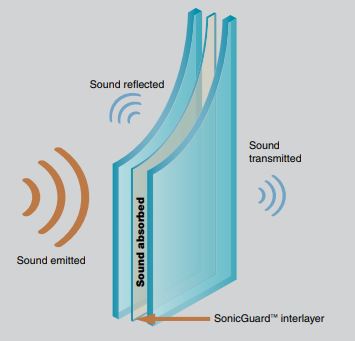Laminated Glass: A Quiet Performer
 Today’s architectural / construction world is demanding. Building owners expect building projects to be energy efficient, provide good air-quality, offer transformative spaces with features like movable walls, be adaptive for future needs, aesthetically beautiful, increase productivity, reduce unwanted noise… the list is incredibly long.
Today’s architectural / construction world is demanding. Building owners expect building projects to be energy efficient, provide good air-quality, offer transformative spaces with features like movable walls, be adaptive for future needs, aesthetically beautiful, increase productivity, reduce unwanted noise… the list is incredibly long.
Construction Canada’s July 2019 cuts through the noise with a great article, written by Robert Marshall, specifically about acoustical consultants and some of the issues / solutions they provide given that “nearly a third of the entire population [in Canada] – work in noisy environments…” The article goes on to note, “This does not come without consequence – regular exposure to excessive noise can stifle learning, productivity, and collaboration in the workplace, and, worse, it contributes to a host of health problems [according to a recent governmental study].”
While the article makes mention of the many innovative building products hitting the market today, they don’t specifically mention laminated glass.
Laminated glass, or more specifically the PVB interlayer, works to absorb acoustic vibrations. The thicker the panes of glass and/or PVB layer, the better the sound reduction will be. Within IGUs laminated glass works extra hard, the larger the air space within the IGU, again the greater the absorption of noise. Largely because the complex make-up of a PVB interlayer sandwiched between two lites of glass and then built within an IGU make a very complex obstacle for noise to travel through.
The complex calculation of noise transmission can be demonstrated by the OITC (Outdoor-Indoor Transmission Class). The larger the number, the better acoustical performance. For example, a standard IGU make-up comprised of two lites (or panes of glass), each lite 6mm Clear glass with a 6mm air space in between them will provide an OITC rating of 28, however, an 8mm SonicGuard™ Lami (outboard lite) with a 20mm airspace and a 12mm SonicGuard™ (inboard lite) will result in an OITC of 38, a 10 point difference! What does a 10-point difference really mean? A reduction of noise by half (or nearly half) it’s decibel volume.
It’s important to note that there are innumerable combinations of glass make-ups that will attain varying acoustical performance benefits. As Robert suggests in the Construction Canada article, it is best to review the goals of your project and to understand the noise challenges that may present once the space is occupied. When reviewing building materials with an acoustical consultant, review glazing options in consideration with the building’s envelope.
To learn more about the various glazing products that will help you find the peace you need on your next project visit: www.vitrum.ca/glass-products/laminated-glass
To view the original article visit: https://www.constructioncanada.net/publications/de/201907/index.html# and click on the cover story, “Optimizing Sound with Expert Help”.